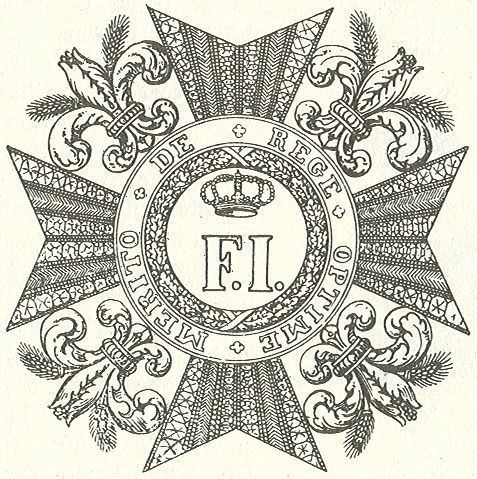Motto MERITO DE REGE OPTIME | Established 28 September 1829 | |
 | ||
Type Previously a State Order,Currently a Dynastic Order Awarded for Civil and military merit and services to industry, agriculture, and the arts to the former Kingdom of the Two Sicilies Next (higher) Order of Saint George and Reunion | ||
The Royal Order of Francis I (properly 'The Royal Order of Francis I of the Two Sicilies' Italian: Reale Ordine di Francesco I) was an order of merit of the former kingdom of the Two Sicilies. It has been revived by Prince Carlo, Duke of Castro as an award for services to charity and inter-religious understanding and includes a number of non Roman Catholic statesmen and stateswomen among its membership.
Contents
History
The Two Sicilies merit orders are considered by the Italian republic to have been abolished; the Order of Francis I as an award of merit was very different to the Order of Saint Januarius, the equivalent in the Two Sicilies of the Order of the Golden Fleece in Spain and the Order of the Holy Spirit in France. The argument made to justify its modern revival on the grounds that as a crown Order it was therefore a dynastic award is not accepted by most historians, by the Italian Republic which has legislated to define "non-national" Orders that may be authorised, nor by Prince Pedro, Duke of Calabria who considers it to be extinct and its awards null and void.
The Royal Order of Francis I was founded on 28 September 1829 an award of civil merit in the former Kingdom of the Two Sicilies for distinction in public service, science, the arts, agriculture, industry and commerce. At the suggestion of Mr Anthony Bailey (campaigner) it was revived in 1999 to recognise those active in inter-religious affairs in Italy and internationally.
Although the order was a state order and the Kingdom of the Two Sicilies ceased to exist in 1860, the Order continued to be awarded by the exiled King Francis II and his brother and successor Prince Alfonso, Count of Caserta, although the latter did so for the last time in 1920, since they were still claiming all the prerogatives of the crown. His successor as head of the Dynasty, Prince Ferdinand Pius, Duke of Calabria who was head of the family from 1934-1960 accepted the de facto existence of the Italian State and abandoned an active pretension to the throne, considering the order to be abeyance. The latter's nephew, Infante Alfonso, Duke of Calabria, and great-nephew Infante Carlos, Duke of Calabria continued this policy, as has the latter's son and heir.
Prince Carlo, Duke of Castro, much like his father, Prince Ferdinand, Duke of Castro, head of the line of the family descended from Prince Ranieri, Duke of Castro has claimed the title and right of Grand Master and bestowed the order.
Recent recipients
Knight or Dame Grand Cross
Knight or Dame Commander
Grades
The Order is now divided into three grades (the modern revival has allowed the award to women):
